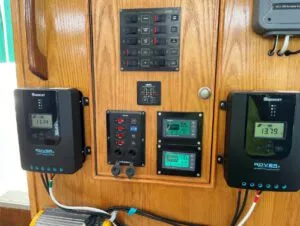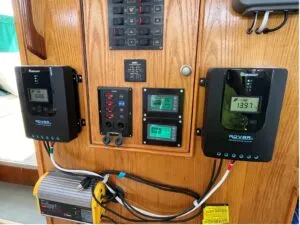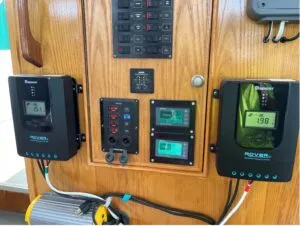The practical aspects of your solar panel system will be governed by the design and size of your sailboat, your overall project budget (% DIY project) and how you currently use your sailboat versus your future plans for your boat. The intent of this article is not to design or size your solar system, but to offer some real-world practical guides and considerations. You may have other sources of power from an auxiliary engine alternator or a separate diesel generator, but ideally you will want to optimize your solar power system generation when possible.
THE DESIGN AND SIZE OF YOUR SAILBOAT
It may seem obvious that the size of your sailboat has a major impact on the design and complexity of any solar power system, but sailboat size is not the only factor to consider, especially when determining what your overall budget might support. Does your sailboat have a dodger, bimini or dinghy davit system? These accessories can considerably aid solar panel installation. Does your sailboat have an AC power system? Does your sailboat design include bulkheads or a floor grid that provide space for cables or hoses to run through freely? Is your sailboat a sloop monohull with center cockpit, a ketch, or is it a catamaran or trimaran? These designs all present opportunities and challenges for solar panel installation, which includes figuring out how to position the panels to maximize sun exposure and minimize shade. The most effective location for solar panels is on a stern dinghy davit arch mounting system. A location that has the least amount of shading from sails, mast, boom and other components is the most effective.
WILL THIS BE A DIY PROJECT AND WHAT IS YOUR BUDGET?

Whether or not you decide to DIY your solar power system hinges on two considerations. What are your skills as a DIYer and what is your budget? If your project is 100% DIY with no contracted services involved, then your budget is 100% for purchased components and supplies. Simply stated, your budget will cover a much more complex solar system if it is 100% DIY. Determining your budget for a 100% DIY project is much easier to estimate versus a hybrid project where a portion of the installation is done via contracted services. It’s important to not only get quotes for the major components, which will provide some firm costs to add to your overall project estimate, but to also develop a bill of materials for all the necessary cables, connectors, accessories, mounting assemblies, etc. Spending time developing this bill of materials will then allow you to estimate the cost of all the materials and supplies needed to install the major components. Costs associated with the materials and supplies can be much larger than you would initially anticipate, so it is critical to spend time and effort developing a realistic overall estimate for your project. This is especially important for more complex systems on larger sailboats with longer cabling routes between various components, custom mounting systems for solar panels and other major components.
HOW DO YOU USE YOUR SAILBOAT NOW AND WHAT ARE YOUR FUTURE PLANS?
Considering what your current use is for your sailboat will help you decide on the complexity of the solar power system. Are you a day sailor, weekend cruiser, vacation cruiser, long distance cruiser, part-time or full-time liveaboard? Do you need to keep your house battery bank charged up while running a refrigerator/freezer on anchor/mooring, are you a weekend/vacation cruiser or do you want to be an off-grid distance cruiser for weeks at a time with most of the “house type” AC power appliances operable onboard?
Is your current sailboat one you plan to keep for some years to come and your use will evolve from weekend cruiser to long distance cruiser? Considering your near term (less than 5 years) future likely use of your sailboat will help you decide on the future complexity of the solar power system. Your initial design should consider what your future system might need to evolve into. If you account for this when selecting cable sizes, installing battery boxes, solar panel support systems, etc., it will save you money and effort for future upgrades.
SOLAR POWER SYSTEM OPERATIONAL CONSIDERATIONS FOR THE DESIGN AND USE ONCE INSTALLED
My experience with solar power systems has been that the installed capacity of solar panels is theoretical, meaning it is based on ideal lab test results. In the practical world on a sailboat, peak sunny day output is about 60% of the manufacturer nameplate rating, while the total day light average is more like 40%. The only way to get higher outputs would be a relatively impractical system where solar panels were constantly adjusted to be at the optimum angle to the sun during the day. For most sailboats, an adjustable solar panel mounting system is not practical to install or to operate.
The other key operational factor is the hours per day of solar panel output to your battery bank versus the hours per day your power consuming devices are “on” and are a load on your battery bank. On the average intermediate complexity sailboat electrical system, the main two loads that are consuming power both day and night are fridges and freezers. This will of course depend on whether you are at anchor or are underway. You may have ventilation fans or lights “on” as conditions require and when underway you will have various navigational systems “on” and consuming power from your battery banks.
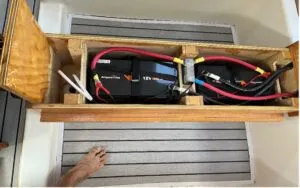

In the above cases, these power loads are for the most part not discretionary operational decisions you will make, so your battery bank is expected to absorb the power load draw irrespective of whether your solar panel system is generating power or not. The benefit of solar power is that it’s free—no fuel will be consumed and your sailboat will not be slowed down, which is the case for hydro-generators or electric motor-based propulsion systems with regeneration capability.
My recommendation is for lithium battery-based systems where every 100 amp-hours of battery capacity is supported by 300 watts of installed nameplate solar panel capacity. This will ensure sufficient real-world practical solar power output to restore about 70 amp-hours of battery charge for each 8-hour day. The combined 300 watts of solar and 100 amp-hours of lithium battery capacity will sustain an average current load of about 3 amps for 24 hours per day in a 12-volt DC system. In the case of my sailboat, I have 200 amp-hours of lithium battery capacity for a second house bank that supports a small fridge, freezer, water pump, two fans and two USB outlets. This size system can handle all the connected loads, which ensures I am self-sustaining for extended cruising. The battery bank will bridge low solar output, which can happen over multiple cloudy or rainy days. This has been my experience cruising from Nova Scotia to Florida.
Most sailboats will be cruising, as in my case, northern areas in summer and southern areas in winter, so those boats can generally count on 8 hours of good solar generation with limited extended cloudy days. As a result, I have discovered with my system, which I believe will be the case with most sailboat solar power systems, there is considerably more solar generation capacity during extended sunny day periods than my non-discretionary loads can consume. In a practical sense, this means my 200 amp-hours of lithium battery bank is fully recharged by late morning most days, leaving my solar panel charge controllers cutting almost completely out for the whole afternoon.
This leaves an operational opportunity to manage discretionary power loads in terms of when I activate these loads. In my case, the discretionary power loads that I can manage are the inverter-supplied 750-watt 120-volt AC heater in my hot water tank, the 120-volt AC charging of device batteries and a 120-volt AC vacuum cleaner. For other sailboat owners, this list might include cabin air conditioning (cooling the cabins down before sundown), 120-volt AC induction cooking and 120-volt AC-operated internet systems like Starlink.
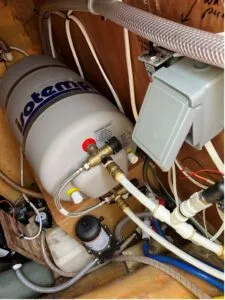
By activating my 2,000-watt inverter and switching “on” my 750-watt 120-volt hot water tank heater, I can draw down my lithium battery bank state of charge (voltage) very quickly and my solar charge controllers respond almost simultaneously to ramp solar power generation to the maximum possible, given the sunlight conditions. This is a manual operational intervention I need to make, but it takes seconds and allows optimization of my solar power system for the remainder of the effective daylight hours. Deciding when to turn “off” hot water tank heating (if temperature control does not do this first) requires a second intervention on my part after observing average solar power input versus the hot water heater power consumption. The hot water heater consumption is constant until the tank temperature control switches it off, so the only judgement I need to make is based on my current sailing course or anchored direction orientation and the cloud state. Weighing those factors helps me determine what my likely solar input will be over the afternoon. With a little practice as the operator, you can judge how long to leave your discretionary power loads activated to optimize available sunlight and still end up at sundown with an acceptable state of battery bank charge, ideally 100%.
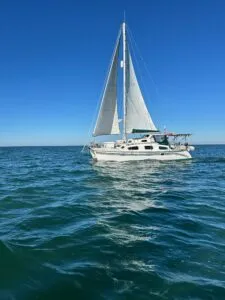
An example of using a discretionary load to optimize solar power generation from my sailboat system is shown below. Note, it is critical to have solar charge controllers that display output as well as a shunt and battery bank monitor to be able to see what loads are on the battery bank. In my case, I have a 2,000-watt inverter with a 750-watt electric heating element in my hot water tank as the main discretionary load. My hot water system is also installed with a circulating loop and propane instantaneous hot water heater when there is not sufficient solar power available for hot water heating.
